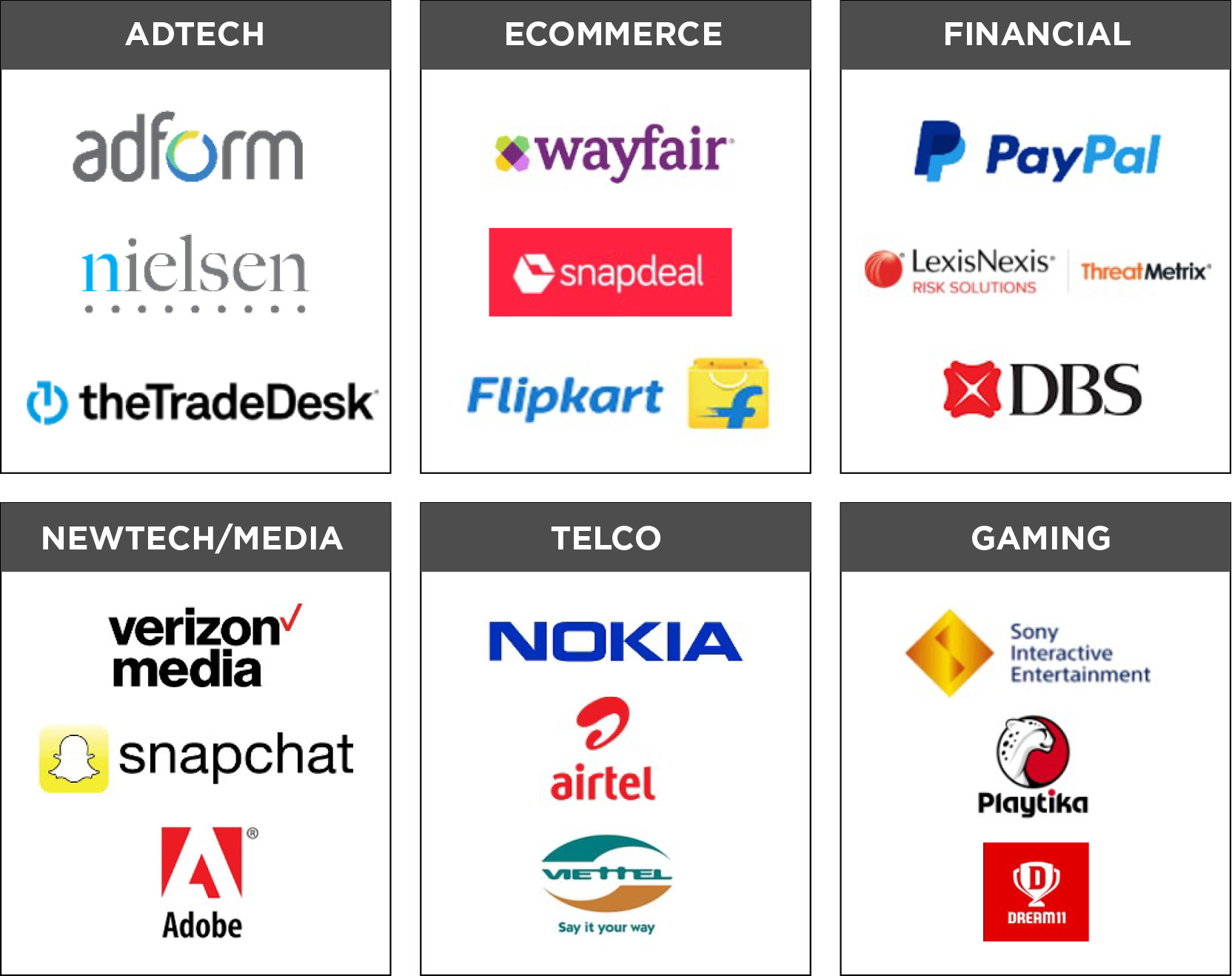Back in 2009, Aerospike’s journey started with the Adtech vertical. Our co-founders figured out that there is a huge opportunity for real-time bidding in the world of Adtech that benefits from data processing with a sub-millisecond response at scale. Over time, several other key attributes (e.g., strong consistency) were added to our software, making it perfect for other verticals such as financial services and telecom.
Today we serve many customers across different verticals, including telecom. Here are just a few:

In the Telecom industry, our use cases include enabling billing/charging, policy control, subscriber data management, and real-time/geospatial microservices solutions. Increasingly, we have customer engagements in the area of multi-access edge compute (MEC)/telco edge. You can read more about this topic in our earlier blog post here on MEC/Edge in Telecom.
But there are many more use cases that we are well-known for in other verticals, which can be expanded into the telco space. In this blog post, I would like to highlight a few of those.
Applying Game-Changing Solutions from Other Verticals to Telecom
As telecommunications companies take a financial hit transitioning to 5G, it’s an excellent time to consider new revenue streams in adjacent areas. For example, let’s look at potential value-added applications, such as fraud detection and prevention, image and video analytics, online gaming, and product recommendations in the context of mobile commerce.
Specifically, when mobile operators transition from 4G to 5G, the resulting network capacity and quality improvement will exact a huge cost because of the money spent on the spectrum and densifying and upgrading the network infrastructure. At the same time, there is no meaningful (if any) increase in their average revenue per user (ARPU) for the enhanced mobile broadband (eMBB) use case.
That’s why it makes sense that telecoms delve into providing some of the value-added applications themselves instead of acting as a “dumb pipe,” – a bandwidth provider who just transfers bits and bytes between the customer’s device and the Internet at large.
Several non-telco applications can have a big payoff. Among them:
Fraud detection/prevention
It’s estimated that in areas such as retail, travel, hospitality, and entertainment, organizations are losing an average of $4.5 million every year because of fraudulent online transactions. Yet only 51% report prioritizing fraud prevention. Aerospike already has a significant presence in this area. For example, PayPal has seen a 30x reduction in fraudulent transactions missed otherwise by leveraging our patent-winning Hybrid Memory Architecture™ (HMA).
Another customer, this time a multinational universal bank, relies on Aerospike’s ultra-low latency, along with the seamless ability to scale to share fraud rules across platforms and facilitate machine learning consistently with millisecond response time for 99.999% of transactions. We have supported this bank’s dataset growing from 3 TB to more than 30 TB in three years. So, how is this relevant for telecoms? Typical areas of fraud in the telecom context include identity theft/ impersonification, stolen device registration in a “Bring Your Own Device” (BYOD) scheme, and last but not least, mobile payment applications. In each area, telecoms can take advantage of our massively scalable, strongly consistent, super-fast data solution in the backend, coupled with respective front-end applications.
Image/video analytics
According to Mordor Intelligence, the facial recognition market was valued at $3.72 billion in 2020, but that’s expected to jump to $11.62 billion in 2026. The technology is expected to be used more in security, online identity verification, healthcare, automotive, smart home, and access control.
For example, A silicon valley based AI company is using the Aerospike database to power their facial recognition solution for a Banking industry client. Anyone who walks into a branch office using the solution undergoes facial recognition to verify identity. The Aerospike database plays a key role by not only storing the metadata of the contour of the human faces, but more importantly, providing that data to the AI module in real time to facilitate a fast and seamless decision.
Image and video analytics are key growth areas for telecoms. Edge infrastructure can aggregate the field data captured by CCTV cameras/input devices and then forward that in the desired format to a central location that houses the system of record (SoR) database. Aerospike’s database is an excellent fit for both. Crucially, Aerospike’s cross-datacenter replication (XDR) technology does the magic in the background by automatically replicating data between the edge database and the SoR database. This allows the SoR database to access the real-time data aggregated by the edge and make it readily available to the AI module for insight generation without compromising speed and relevance.
What’s at play for telecoms here? Telecoms’ physical locations and buildings (e.g., signal access points, cable/telco hubs) in metro areas can facilitate the edge deployments and aggregate field data for the core SoR database in more central locations. This scheme allows telecoms to offer custom-developed services based on image and video analytics to enterprises and local/ federal governments.
Online gaming
In 2020, the global online PC gaming market was worth $42.2 billion and is projected to hit $46.7 billion by 2025. However, the online mobile gaming market is expected to see a much sharper increase, with a double-digit CAGR.
Aerospike’s unique patented technology can deliver on key priorities through an ability to store, manage and retrieve massive volumes of player and game information; provide instant response time and rapid, iterative development; deliver high availability; and supply a distributed database system that runs on low-cost commodity servers.
For example, India-based Dream 11 was having operational issues in 2020. They solved this problem with Aerospike, which enabled them to handle more than 100 million sport fan users, grow 30 percent, and achieve 1 million transactions per second in under 15 milliseconds of latency.
In another case, a leading gaming company Playtika used Aerospike to cut server footprint 6x, boost performance 300 percent, grow data by 70 percent, and save a projected $1.4 million to $4.2 million over three years.
Telecoms hold a key advantage here as they own the end-user relationship, including direct visibility of device usage patterns. The key opportunity here is to maintain oversight of their in-game engagements, extract insights, analyze that in the backend and then make upsell/cross-sell offers while the users are still on their mobile devices. From the database perspective, the requirements are to provide subscriber profile information in real time both to front-end applications and the back-end analytics engine. This is something that Aerospike excels at and offers a competitive advantage for our customers.
Product recommendation in mobile commerce
The pandemic caused an explosion of online shopping for goods and services, with some $105 billion added to e-commerce in the U.S. in 2020. Consumers were also paying attention to what other people were buying. One study found that product recommendations can boost product sales by 11 percent. It’s not news that within the larger e-commerce bucket, a critical subset is mobile commerce (m-commerce).
As described earlier, Aerospike’s real-time data platform can process data at the edge and combine it with the SoR to power recommendation engines. It can also efficiently power AI/ML inference models at petabyte scale to support e-commerce and retail Systems of Engagement applications for real-time decisions with a fraction of the servers that other technologies require.
While many companies have scrambled to amp up their online e-commerce products and services to meet consumer demand during the last couple of years, Wayfair, a leading online furniture retailer and a significant Aerospike customer was already on the leading edge of e-commerce. Wayfair turned to Aerospike years ago to make their environment highly scalable, substantially increase the flexibility of their data architecture, and significantly reduce server footprint. Aerospike delivered faster reads and writes, averaging 100,000 reads/sec and 20,000 writes/sec. Wayfair leverages Aerospike for customer scoring and segmentation, tracking online events, onsite ads, and recommendation engines. They have cut their server footprint for ad tech to one-eighth of its previous size and use both the cloud and on-premises storage to scale up or down as needed in order to control costs.
Like the online gaming use case, telecoms are also in a unique position to track app usage by their subscribers. Telecoms can bring in insights from cross-app analytics and offer that to individual apps (e-commerce/m-commerce apps in this case) to shorten the sales cycle and enlarge the shopping cart. In some developing markets, it’s not uncommon to see telcos offering virtual malls and acting as an integrated platform of e-commerce/m-commerce apps, sort of a “super app of apps.”
Just this past month, AWS made a major announcement highlighting the value of their partnership with Aerospike. Currently, this partnership is focused on the Adtech vertical, but if clients from another vertical would like to partner in providing a joint solution, we will be open to engaging. Aerospike’s powerful real-time data platform is vertical agnostic. As a result, there is huge potential in cross-referencing use cases among different industries. We look forward to working with you to replicate our market-leading non-telecom use cases in the telco space.
Do you have complimentary technology or do you offer services in this space? If so, learn more about becoming an Aerospike partner today.




